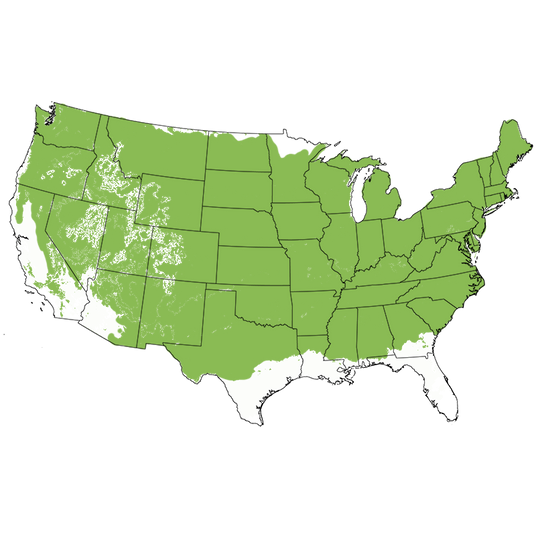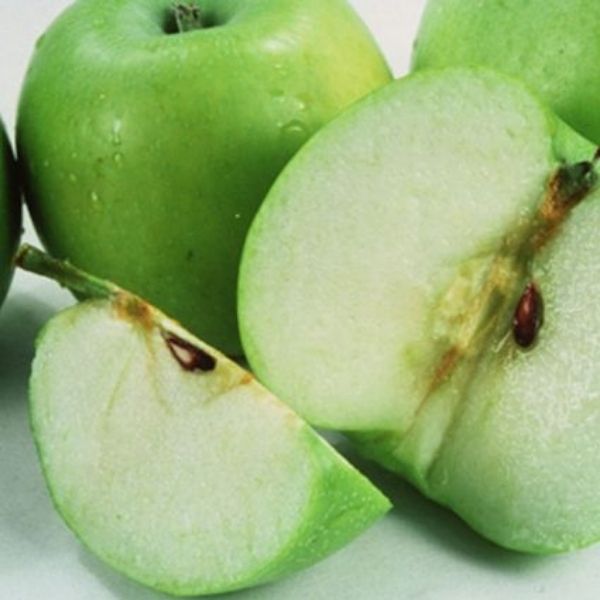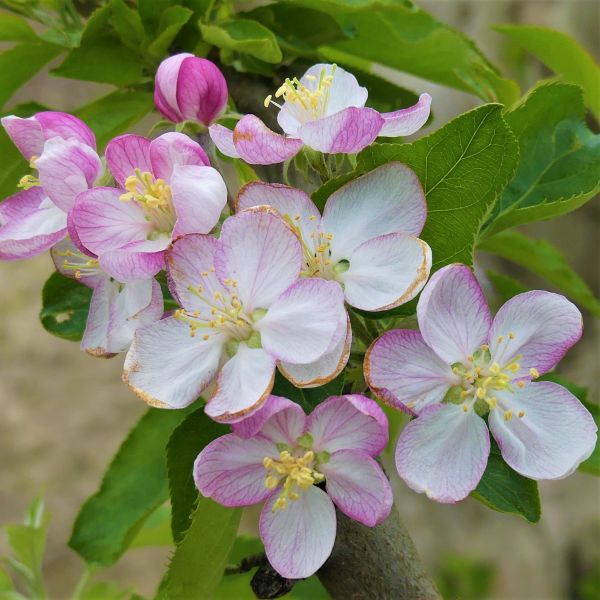Mutsu Apple Tree
Malus 'Mutsu'
- Stay Protected with Plant Sentry ™
Mutsu Apple Tree - #3 Container 4-5 Feet is backordered and will ship as soon as it is back in stock.
Plant Sentry™
Plant Sentry™

Plant Sentry™ Protected
Your order is protected by our compliance system that:
- Prevents restricted plants from shipping to your state
- Ensures plants meet your state's agricultural requirements
- Protects gardens from invasive pests and diseases
Delivery and Shipping
Delivery and Shipping
Delivery and Shipping
Fast, Safe Plant Delivery
Ships in 3-4 business days • Tracking provided • Weather protected
| Under $50 | $9.99 |
| $50 - $99.99 | $14.99 |
| $100 - $149.99 | $16.99 |
| $150 - $198.99 | $24.99 |
| $199+ | FREE |
✓ Zone-specific timing • ✓ Professional packaging • ✓ Health guarantee
Understanding Plant Options
Nature Hills offers plants in two main formats:
- Container Plants: Grown in pots with soil, sized by container volume and plant age
- Bare Root Plants: Dormant plants without soil, sized by height measurements
Container Plant Sizes
Container sizes indicate plant age and growing capacity rather than liquid volume equivalents. Our containers follow industry-standard nursery "trade gallon" specifications, which differ from standard liquid gallon measurements.
Young Plants (6 months to 18 months old)
| Container Size | Actual Volume | Metric Equivalent |
|---|---|---|
| 2" x 2" x 3" | 0.18 - 0.21 dry quarts | 0.20 - 0.23 dry liters |
| 4" Container | 0.31 - 0.87 dry quarts | 0.35 - 0.96 dry liters |
| 4.5" Container | 0.65 dry quarts | 0.72 dry liters |
| 6" Container | 1.4 dry quarts | 1.59 dry liters |
| 1 Quart | 1 dry quart | 1.1 dry liters |
| 5.5" Container | 1.89 dry quarts | 2.08 dry liters |
Established Plants (18 months to 2.5 years old)
| Container Size | Actual Volume | Metric Equivalent |
|---|---|---|
| 2 Quart | 2 dry quarts | 2.2 dry liters |
| #1 Container | 2.26 - 3.73 dry quarts | 2.49 - 4.11 dry liters |
| 5" x 5" x 12" | 3.5 - 4.3 dry quarts | 3.85 - 4.74 dry liters |
Mature Plants (2-4 years old)
| Container Size | Actual Volume | Metric Equivalent |
|---|---|---|
| #2 Container | 1.19 - 1.76 dry gallons | 5.24 - 7.75 dry liters |
| #3 Container | 2.15 - 2.76 dry gallons | 8.14 - 12.16 dry liters |
Large Plants (3-5 years old)
| Container Size | Actual Volume | Metric Equivalent |
|---|---|---|
| #5 Container | 2.92 - 4.62 dry gallons | 12.86 - 20.35 dry liters |
| #6 Container | 5.25 - 6.01 dry gallons | 23.12 - 26.42 dry liters |
| #7 Container | 5.98 - 6.53 dry gallons | 26.34 - 28.76 dry liters |
Bare Root Plants
Bare root plants are sold by height from the root system to the top of the plant. Plants may exceed minimum height requirements.
Common Sizes:
- Trees: 1 foot, 2 feet, 3 feet, 4 feet, 5 feet, 6 feet
- Shrubs & Perennials: 1 foot, 18 inches, 2 feet
Important Notes
Container Volume Specifications
- Trade Gallon Standard: Our containers follow industry-standard "trade gallon" specifications established by the American National Standards Institute (ANSI Z60.1) for nursery stock
- Volume Variations: Actual soil volume may vary due to plant root systems and growing medium settlement
- Age Indicators: Container size primarily indicates plant age and maturity rather than liquid volume equivalents
Growing Conditions
- Plant size can vary based on variety and growing conditions
- Container size helps indicate plant maturity and establishment level
- Larger containers generally mean more established root systems and faster landscape establishment
Seasonal Availability
- Bare root plants are available seasonally when dormant
- Container plants are available throughout the growing season
- Specific varieties may have limited availability in certain sizes
Questions?
For questions about specific plant sizes or availability, please contact our plant experts who can help you choose the right size for your landscape needs.
Plant Highlights
Mutsu Apple Tree highlights at a glance!
-
Botanical Name
-
Brand
-
Growing Zones4, 5, 6, 7, 8
-
Growth RateModerate
-
Mature Height
-
Mature Width
-
Leaf Color
-
Flower Color
-
Fall Color
-
Pollinator FriendlyYes
-
Pollinator Required
-
Bloom PeriodLate Spring
-
FragrantYes
Characteristics
Where To Plant
When To Prune
- Late Winter
Water & Moisture Needs
- Moderate
Sunlight Needs
Soil Needs
- Widely Adaptable

Growing Zones
The Mutsu Apple Tree (Malus 'Mutsu'), also known as the Crispin, is a cross between Golden Delicious and Indo Apple, and is a cultivar first grown in Japan. It is a large to very large, greenish-yellow skin with a conical shape and an incredible sweet-tart flavor. Crisp and juicy with an alluring hint of tartness, the Mutsu has a unique exotic flare. Some say the flavor is closer to apple cider.
The Mutsu apple tree provides its bounty in September, and what a bounty it is! It has creamy white flesh and is delicious when eaten right off the tree.;
Your Mutsu not only provides outstanding fruit but is also an attractive tree for the home landscape. Spring flowers will adorn your tree with their subtle pinks and whites, drawing pollinators to your yard. Its vibrant, green leaves present a lush, healthy appearance for your yard all summer long.
Planting and Application:
Replace that simple flowering tree in your yard with one that also produces loads of healthy fruit! Large enough to cast fantastic shade and small enough for most yards, these are appealing ornamental edible landscaping trees for a wide range of climates and conditions!
Mutsu apples tend to be quite large; with a round shape and yellow coloration that has green tones. It also is an excellent apple for baking, pies, sauces, salads and long-term storage. The Mutsu tends to be a prolific producer so you're sure to have plenty to share.
- Large to Very Large Green-Golden Fruit
- Small Size - Prolific Producer
- Requires Pollinator
- Sweet-Tart Crispy Flavor
- Fragrant Pinkish-White Blossoms
#ProPlantTips for Care:
Easy to grow, Apples and other fruit trees do best in full sun and planted in well-drained soil that has moderate fertility. Provide ample water throughout the growing season and a thick layer of mulch for insulation and moisture retention.
Among the various choices in Apple Trees, the Mutsu is certainly an excellent one! It's easy to see why it's called a "million-dollar apple" and its large size has contributed to the nickname, "oven buster" because you don't need many to make a pie. Order yours today from NatureHills.com and get growing today!
Mutsu Apple Tree Frequently Asked Questions
When to Plant Mutsu Apple Trees
Planting Bareroot trees as soon as you can dig a hole in spring and until hot weather, the earlier the better. Plant container Apple trees throughout the growing season with complete success - that is the benefit of container plants - to extend the planting season. Your County Agricultural Extension Office is a great resource for first and last frost dates in your area.
How to Plant Mutsu Apple Trees
Dig a large hole only as deep as needed to accommodate the bareroot or container root ball, and twice as wide. Add Nature Hills Root Booster to speed root establishment. Remove the pot or bag and situate it into the hole so the top of the soil (soil line if bareroot), is level with the new location's soil being careful not to plant too deep. Water in again very well and backfill with the same soil you dug up, tamping down gently to ensure there are no air pockets.
Top off with a 3-4 inch thick layer of Arborist mulch. Consider staking your tree to keep its trunk growing straight for the first year to ensure it stands tall against strong winds and drifting snow.
When to Prune Mutsu Apple Trees
Trim off any broken branches from delivery as soon as you take them out of the box. Prune and trim apple trees while dormant, in late winter or early spring, before you see new growth.
How to Prune Mutsu Apple Trees
Dormant prune to:
- Remove any double leaders or narrow crotch angles
- Eliminate any crossing branches
- Thin interior branching and leave the fruiting spurs and strong branches in place opening up the canopy
- Branching at least 24-36 inches above the ground
Prune Apple trees in the summer to:
- Control size and shape by reducing the length of longer new growth on vigorous trees
- Remove water sprouts on the main trunk or older branches in the crown
- Remove suckers at the base of the trunk
- Thin fruit during heavy years on established trees
How to Care for Mutsu Apple Trees
Growing an apple tree is easy when proper soil, good drainage, attention to moisture, and regular fertility are maintained. Once you've chosen an apple tree that works for your climate, in the size you need for your landscape, and its pollinator (if needed), then you've accomplished half the battle!
- Apple trees do best in full sun and well-drained soil
- Water your apple trees when it gets dry - especially during the fruit production stage, and drought periods to keep it stress-free
- Use arborists' wood chips to mulch over the roots of your apples and have your soil tested to see what your soil may be lacking before adding fertilizers
- Maintenance pruning and shaping
Apple trees will tolerate a wide range of soils, so long as water and nutrients are not limited and the pH level is adequate.
How to Fertilize Mutsu Apple Trees
For the first year, water alone is most important. It is always best to get a soil test to see what your soil is lacking before adding more fertilizers. Once established, a fertilizer routine may be beneficial. We do offer some excellent slow-release organic options, applied according to the package directions.
Fruit trees need more phosphate and it's possible to apply too much nitrogen which affects the soil's pH. Test soil acidity or alkalinity using a pH Tester.
Fertilize in spring when you first see new growth emerging.
- Don't overdo it
- Phosphates are your friends
- Pay attention to pH in areas with extremely high or low soil pH
- Follow the directions
Mutsu Apple Tree Pollinating Info
Mutsu is not self-fruiting and needs a pollinating partner. Pair with one of these varieties:
- Empire Apple Tree
- Fuji Apple Tree
- Gala Apple Tree
- Golden Delicious Apple Tree
- Honeycrisp Apple Tree
- Red Jonathan Apple Tree
- Granny Smith Apple Tree
- McIntosh Apple Tree
- Pixie Crunch Apple Tree
Harvest Times for Mutsu Apple Trees
Mutsu’s are typically ready to harvest in September.
Early-Season? Mid-Season? Late-Season? The terminology can be confusing for new apple tree growers. Weather, climate and your tree determine when it's ripe.
For Apples:
- Early-season is usually June-July
- Mid-season can be August-September
- Late-season can be from late September-November
The growing season consists of spring, summer, and fall, and varies with climate and weather. Areas with longer growing seasons in the warmer hardiness zones can greatly affect the harvest times for each particular apple variety grown in your area.
Huge, Delicious and Versatile
The Mutsu apple - also known as the Crispin - has long been considered the connoisseurs cooking and baking apple. With its modest introduction and high-end specialized group of admirers in the past, the Mutsu may finally get the just recognition it deserves by those seeking high quality fruit today.
This was one of the first crosses done at the Japanese Apple Research Institute in Kuroshio City, Aomori Japan after it officially opened in 1931.
A cross between the Golden Delicious apple and the Indo apple, the Mutsu apple is named after the Mutsu Province of Japan an area in northern Japan which includes the Aomori Prefecture. Aomori is one of the largest apples growing regions in Japan dating back to 1875.
Introduced for sale in 1948, it was not until the mid-1960's that is was introduced outside of Japan, first under the name Crispin. The name Crispin did not catch on and Mutsu would remain its common name in the United States.
Today, Aomori Prefecture produces over 50 million tons of apples a year and is known for the exceptionally large fruit they are able to produce. The Mutsu apple is already a large fruit. On average, each fruit coming from the Aomori growers is a one-pound apple.
In 2005, the Guinness World Records recorded the world heaviest Apple, a variety named Hokuto (Fuji x Mutsu) that weighed 1.849 Kg or almost 5 pounds!
Also, a signature of the region is the bagging of each individual fruit on the tree to protect them from insect damage. The growers pride themselves on growing the world finest apples, which command top dollar. Many other varieties including the Fuji apple have found their road to fame through the Aomori Prefecture growers of Japan.
Enjoy!










